Advances in Functional Cellulose Hydrogels as Electrolytes for Flexible Zinc-Ion Batteries
Abstract
1. Introduction
2. Fundamentals of Hydrogel and Cellulose
2.1. Hydrogels
2.2. Celluloses
3. Crosslinking of Cellulose Hydrogels
3.1. Physical Crosslinking
3.2. Chemical Crosslinking
3.3. Crosslinking Assisted by Radiation
3.3.1. Gamma Ray Radiation
3.3.2. Electron-Beam Radiation
3.3.3. Ultraviolet Radiation
3.3.4. Microwave Radiation
4. Applications of Cellulose Hydrogels in ZIBs
4.1. Anti-Freezing ZIBs
4.2. Self-Healing ZIBs
4.3. Smart ZIBs
5. Summary and Outlook
Funding
Conflicts of Interest
References
- Liu, W.; Song, M.-S.; Kong, B.; Cui, Y. Flexible and Stretchable Energy Storage: Recent Advances and Future Perspectives. Adv. Mater. 2017, 29, 1603436. [Google Scholar] [CrossRef] [PubMed]
- Wang, J.; Li, S.; Yi, F.; Zi, Y.; Lin, J.; Wang, X.; Xu, Y.; Wang, Z.L. Sustainably powering wearable electronics solely by biomechanical energy. Nat. Commun. 2016, 7, 12744. [Google Scholar] [CrossRef] [PubMed]
- Zhang, H.; Liu, X.; Li, H.; Hasa, I.; Passerini, S. Challenges and Strategies for High-Energy Aqueous Electrolyte Rechargeable Batteries. Angew. Chem. Int. Ed. 2021, 60, 598–616. [Google Scholar] [CrossRef] [PubMed]
- Chen, Y.; Kang, Y.; Zhao, Y.; Wang, L.; Liu, J.; Li, Y.; Liang, Z.; He, X.; Li, X.; Tavajohi, N.; et al. A review of lithium-ion battery safety concerns: The issues, strategies, and testing standards. J. Energy Chem. 2021, 59, 83–99. [Google Scholar] [CrossRef]
- Du, W.; Ang, E.H.; Yang, Y.; Zhang, Y.-F.; Ye, M.; Li, C.C. Challenges in the material and structural design of zinc anode towards high-performance aqueous zinc-ion batteries. Energy Environ. Sci. 2020, 13, 3330–3360. [Google Scholar] [CrossRef]
- Wang, S.; Lu, S.; Yang, X.; Liu, X. Pseudocapacitive MoOx anode material with super-high rate and ultra-long cycle properties for aqueous zinc ion batteries. J. Electroanal. Chem. 2021, 882, 115033. [Google Scholar] [CrossRef]
- Virya, A.; Lian, K. A review of neutral pH polymer electrolytes for electrochemical capacitors: Transitioning from liquid to solid devices. Mater. Rep. Energy 2021, 1, 100005. [Google Scholar] [CrossRef]
- Zhou, D.; Shanmukaraj, D.; Tkacheva, A.; Armand, M.; Wang, G. Polymer Electrolytes for Lithium-Based Batteries: Advances and Prospects. Chem 2019, 5, 2326–2352. [Google Scholar] [CrossRef]
- Wang, X.; Zhang, W.; Zhou, Q.; Ran, F. Integrating supercapacitor with sodium hyaluronate based hydrogel as a novel All-In-One wound Dressing: Self-Powered electronic stimulation. Chem. Eng. J. 2023, 452, 139491. [Google Scholar] [CrossRef]
- Lu, K.; Jiang, T.; Hu, H.; Wu, M. Hydrogel Electrolytes for Quasi-Solid Zinc-Based Batteries. Front. Chem. 2020, 8, 546728. [Google Scholar] [CrossRef]
- Nan, J.; Zhang, G.; Zhu, T.; Wang, Z.; Wang, L.; Wang, H.; Chu, F.; Wang, C.; Tang, C. A Highly Elastic and Fatigue-Resistant Natural Protein-Reinforced Hydrogel Electrolyte for Reversible-Compressible Quasi-Solid-State Supercapacitors. Adv. Sci. 2020, 7, 2000587. [Google Scholar] [CrossRef] [PubMed]
- Yu, M.; Ji, X.; Ran, F. Chemically building interpenetrating polymeric networks of Bi-crosslinked hydrogel macromolecules for membrane supercapacitors. Carbohydr. Polym. 2021, 255, 117346. [Google Scholar] [CrossRef] [PubMed]
- Zeng, X.; Mao, J.; Hao, J.; Liu, J.; Liu, S.; Wang, Z.; Wang, Y.; Zhang, S.; Zheng, T.; Liu, J.; et al. Electrolyte Design for In Situ Construction of Highly Zn2+-Conductive Solid Electrolyte Interphase to Enable High-Performance Aqueous Zn-Ion Batteries under Practical Conditions. Adv. Mater. 2021, 33, 2007416. [Google Scholar] [CrossRef] [PubMed]
- Tran, T.N.T.; Chung, H.-J.; Ivey, D.G. A study of alkaline gel polymer electrolytes for rechargeable zinc–air batteries. Electrochim. Acta 2019, 327, 135021. [Google Scholar] [CrossRef]
- Zhang, T.; Shi, X.; Li, Y.; Sangaraju, S.; Wang, F.; Yang, L.; Ran, F. Carboxylic bacterial cellulose fiber-based hydrogel electrolyte with imidazole-type ionic liquid for dendrite-free zinc metal batteries. Mater. Rep. Energy 2024, 4, 100272. [Google Scholar] [CrossRef]
- Li, S.; Fu, J.; Miao, G.; Wang, S.; Zhao, W.; Wu, Z.; Zhang, Y.; Yang, X. Toward Planar and Dendrite-Free Zn Electrodepositions by Regulating Sn-Crystal Textured Surface. Adv. Mater. 2021, 33, 2008424. [Google Scholar] [CrossRef]
- Yang, Q.; Li, Q.; Liu, Z.; Wang, D.; Guo, Y.; Li, X.; Tang, Y.; Li, H.; Dong, B.; Zhi, C. Dendrites in Zn-Based Batteries. Adv. Mater. 2020, 32, 2001854. [Google Scholar] [CrossRef]
- Yi, Z.; Chen, G.; Hou, F.; Wang, L.; Liang, J. Zinc-Ion Batteries: Strategies for the Stabilization of Zn Metal Anodes for Zn-Ion Batteries (Adv. Energy Mater. 1/2021). Adv. Energy Mater. 2021, 11, 2170001. [Google Scholar] [CrossRef]
- Xie, C.; Li, Y.; Wang, Q.; Sun, D.; Tang, Y.; Wang, H. Issues and solutions toward zinc anode in aqueous zinc-ion batteries: A mini review. Carbon Energy 2020, 2, 540–560. [Google Scholar] [CrossRef]
- Aziz, S.B.; Woo, T.J.; Kadir, M.F.Z.; Ahmed, H.M. A conceptual review on polymer electrolytes and ion transport models. J. Sci. Adv. Mater. Devices 2018, 3, 1–17. [Google Scholar] [CrossRef]
- Bocharova, V.; Sokolov, A.P. Perspectives for Polymer Electrolytes: A View from Fundamentals of Ionic Conductivity. Macromolecules 2020, 53, 4141–4157. [Google Scholar] [CrossRef]
- Wu, K.; Huang, J.; Yi, J.; Liu, X.; Liu, Y.; Wang, Y.; Zhang, J.; Xia, Y. Recent Advances in Polymer Electrolytes for Zinc Ion Batteries: Mechanisms, Properties, and Perspectives. Adv. Energy Mater. 2020, 10, 1903977. [Google Scholar] [CrossRef]
- Zhao, F.; Bae, J.; Zhou, X.; Guo, Y.; Yu, G. Nanostructured Functional Hydrogels as an Emerging Platform for Advanced Energy Technologies. Adv. Mater. 2018, 30, 1801796. [Google Scholar] [CrossRef] [PubMed]
- Gajewski, P.; Béguin, F. Hydrogel–Polymer Electrolyte for Electrochemical Capacitors with High Volumetric Energy and Life Span. ChemSusChem 2020, 13, 1876–1881. [Google Scholar] [CrossRef]
- Zhang, H.; Gu, J.; Tong, J.; Ma, C.; Zhao, J.; Zhang, X.; Wang, C. Poly(ethylene oxide)–poly(propylene oxide)–poly(ethyl oxide) enhancing capacitance behavior of composite electrode material poly(o-phenylenediamine)/manganese dioxide for supercapacitor. Energy Convers. Manag. 2015, 91, 120–131. [Google Scholar] [CrossRef]
- Xiao, S.; Yang, Y.; Zhong, M.; Chen, H.; Zhang, Y.; Yang, J.; Zheng, J. Salt-Responsive Bilayer Hydrogels with Pseudo-Double-Network Structure Actuated by Polyelectrolyte and Antipolyelectrolyte Effects. ACS Appl. Mater. Interfaces 2017, 9, 20843–20851. [Google Scholar] [CrossRef]
- Yao, X.; Liu, J.; Yang, C.; Yang, X.; Wei, J.; Xia, Y.; Gong, X.; Suo, Z. Hydrogels: Hydrogel Paint (Adv. Mater. 39/2019). Adv. Mater. 2019, 31, 1970276. [Google Scholar] [CrossRef]
- Barhoum, A.; Jeevanandam, J.; Rastogi, A.; Samyn, P.; Boluk, Y.; Dufresne, A.; Danquah, M.K.; Bechelany, M. Plant celluloses, hemicelluloses, lignins, and volatile oils for the synthesis of nanoparticles and nanostructured materials. Nanoscale 2020, 12, 22845–22890. [Google Scholar] [CrossRef]
- Mckee, J.R.; Appel, E.A.; Seitsonen, J.; Kontturi, E.; Scherman, O.A.; Ikkala, O. Healable, Stable and Stiff Hydrogels: Combining Conflicting Properties Using Dynamic and Selective Three-Component Recognition with Reinforcing Cellulose Nanorods. Adv. Funct. Mater. 2014, 24, 2706–2713. [Google Scholar] [CrossRef]
- Gupta, P.K.; Raghunath, S.S.; Prasanna, V.; Venkat, P.; Geetha, K. An Update on Overview of Cellulose, Its Structure and Applications. Cellulose 2019, 201, 84727. [Google Scholar]
- Schurz, J. A bright future for cellulose. Prog. Polym. Sci. 1999, 24, 481–483. [Google Scholar] [CrossRef]
- Klemm, D.; Heublein, B.; Fink, H.P.; Bohn, A. Cellulose: Fascinating Biopolymer and Sustainable Raw Material. Angew. Chem. Int. Ed. 2005, 44, 3358–3393. [Google Scholar] [CrossRef] [PubMed]
- Rose, M.; Palkovits, R. Cellulose-Based Sustainable Polymers: State of the Art and Future Trends. Macromol. Rapid Commun. 2011, 32, 1299–1311. [Google Scholar] [CrossRef] [PubMed]
- Bhaladhare, S.; Das, D. Cellulose: A fascinating biopolymer for hydrogel synthesis. J. Mater. Chem. B 2022, 10, 1923–1945. [Google Scholar] [CrossRef]
- Das, D.; Prakash, P.; Rout, P.K.; Bhaladhare, S. Synthesis and Characterization of Superabsorbent Cellulose-Based Hydrogel for Agriculture Application. Starch-Stärke 2021, 73, 1900284. [Google Scholar] [CrossRef]
- Sannino, A.; Demitri, C.; Madaghiele, M. Biodegradable Cellulose-based Hydrogels: Design and Applications. Materials 2009, 2, 353–373. [Google Scholar] [CrossRef]
- Krystynowicz, A.; Czaja, W.; Wiktorowska-Jezierska, A.; Gonçalves-Miśkiewicz, M.; Turkiewicz, M.; Bielecki, S. Factors affecting the yield and properties of bacterial cellulose. J. Ind. Microbiol. Biotechnol. 2002, 29, 189–195. [Google Scholar] [CrossRef]
- Ma, L.; Bi, Z.; Xue, Y.; Zhang, W.; Huang, Q.; Zhang, L.; Huang, Y. Bacterial cellulose: An encouraging eco-friendly nano-candidate for energy storage and energy conversion. J. Mater. Chem. A 2020, 8, 5812–5842. [Google Scholar] [CrossRef]
- Hickey, R.J.; Pelling, A.E. Cellulose Biomaterials for Tissue Engineering. Front. Bioeng. Biotechnol. 2019, 7, 45. [Google Scholar] [CrossRef]
- Fijul, K.S.M.; Sikdar, P.P.; Haque, B.; Rahman, B.M.A.; Ali, A.; Islam, M.N. Cellulose-based hydrogel materials: Chemistry, properties and their prospective applications. Prog. Biomater. 2018, 7, 153–174. [Google Scholar]
- Mondal, M. Cellulose-Based Superabsorbent Hydrogels|Cellulose-Based Hydrogels for Wound Healing. In Polymers and Polymeric Composites: A Reference Series; Springer: Berlin/Heidelberg, Germany, 2018; pp. 1–18. [Google Scholar] [CrossRef]
- Fu, L.H.; Qi, C.; Ma, M.G.; Wan, P. Multifunctional Cellulose-based Hydrogels for Biomedical Applications. J. Mater. Chem. B 2018, 7, 1541–1562. [Google Scholar] [CrossRef] [PubMed]
- Javad, S.; Khosro, A. Application of Cellulose and Cellulose Derivatives in Pharmaceutical Industries. In Cellulose; Theo van de, V., Louis, G., Eds.; IntechOpen: Rijeka, Croatia, 2013; Chapter 3. [Google Scholar]
- Li, Y.-Y.; Wang, B.; Ma, M.-G.; Wang, B. Review of Recent Development on Preparation, Properties, and Applications of Cellulose-Based Functional Materials. Int. J. Polym. Sci. 2018, 2018, 8973643. [Google Scholar] [CrossRef]
- Praveen Kumar, G.; Shreeya Sai, R.; Deepali Venkatesh, P.; Priyadharsini, V.; Vidhya, S.; Chandrananthi, C.; Shreya, C.; Krithika, S.; Keerthana, G. An Update on Overview of Cellulose, Its Structure and Applications. In Cellulose; Alejandro Rodríguez, P., María, E.E.M., Eds.; IntechOpen: Rijeka, Croatia, 2019; Chapter 4. [Google Scholar]
- Seddiqi, H.; Oliaei, E.; Honarkar, H.; Jin, J.; Geonzon, L.C.; Bacabac, R.G.; Klein-Nulend, J. Cellulose and its derivatives: Towards biomedical applications. Cellulose 2021, 28, 1893–1931. [Google Scholar] [CrossRef]
- Jasmania, L.; Thielemans, W. Preparation of nanocellulose and its potential application. Int. J. Nanomater. Nanotechnol. Nanomed. 2018, 4, 14–21. [Google Scholar] [CrossRef]
- Trache, D.; Tarchoun, A.F.; Derradji, M.; Hamidon, T.S.; Masruchin, N.; Brosse, N.; Hussin, M.H. Nanocellulose: From Fundamentals to Advanced Applications. Front. Chem. 2020, 8, 392. [Google Scholar] [CrossRef]
- Liu, Y.; Ahmed, S.; Sameen, D.E.; Wang, Y.; Lu, R.; Dai, J.; Li, S.; Qin, W. A review of cellulose and its derivatives in biopolymer-based for food packaging application. Trends Food Sci. Technol. 2021, 112, 532–546. [Google Scholar] [CrossRef]
- Liu, K.; Du, H.; Zheng, T.; Liu, H.; Zhang, M.; Zhang, R.; Li, H.; Xie, H.; Zhang, X.; Ma, M.; et al. Recent advances in cellulose and its derivatives for oilfield applications. Carbohydr. Polym. 2021, 259, 117740. [Google Scholar] [CrossRef]
- Alam, M.N.; Islam, M.S.; Christopher, L.P. Sustainable Production of Cellulose-Based Hydrogels with Superb Absorbing Potential in Physiological Saline. ACS Omega 2019, 4, 9419–9426. [Google Scholar] [CrossRef]
- Christian, D.; Marta, M.; Maria Grazia, R.; Alessandro, S.; Luigi, A. Investigating the Structure-Related Properties of Cellulose-Based Superabsorbent Hydrogels. In Hydrogels; Lăcrămioara, P., Mihaela Violeta, G., Cristina-Elena, D.-P., Eds.; IntechOpen: Rijeka, Croatia, 2018; Chapter 3. [Google Scholar]
- Dutta, S.; Lim, K.-T. Functional cellulose-based hydrogels as extracellular matrices for tissue engineering. J. Biol. Eng. 2019, 13, 55. [Google Scholar] [CrossRef]
- Esposito, F.; Nobile, M.A.D.; Mensitieri, G.; Nicolais, L. Water sorption in cellulose-based hydrogels. J. Appl. Polym. Sci. 1996, 60, 2403–2407. [Google Scholar] [CrossRef]
- Navarra, M.A.; Dal Bosco, C.; Serra Moreno, J.; Vitucci, F.M.; Paolone, A.; Panero, S. Synthesis and Characterization of Cellulose-Based Hydrogels to Be Used as Gel Electrolytes. Membranes 2015, 5, 810–823. [Google Scholar] [CrossRef] [PubMed]
- Xiao, M.; Hu, J.; Zhang, L. Synthesis and Swelling Behavior of Biodegradable Cellulose-Based Hydrogels. Adv. Mater. Res. 2014, 1033–1034, 352–356. [Google Scholar] [CrossRef]
- Lin, F.; Wang, Z.; Chen, J.; Lu, B.; Tang, L.; Chen, X.; Lin, C.; Huang, B.; Zeng, H.; Chen, Y. A bioinspired hydrogen bond crosslink strategy toward toughening ultrastrong and multifunctional nanocomposite hydrogels. J. Mater. Chem. B 2020, 8, 4002–4015. [Google Scholar] [CrossRef] [PubMed]
- Mredha, M.T.I.; Guo, Y.Z.; Nonoyama, T.; Nakajima, T.; Kurokawa, T.; Gong, J.P. A Facile Method to Fabricate Anisotropic Hydrogels with Perfectly Aligned Hierarchical Fibrous Structures. Adv. Mater. 2018, 30, 1704937. [Google Scholar] [CrossRef] [PubMed]
- Zhang, T.; Zuo, T.; Hu, D.; Chang, C. Dual Physically Cross-Linked Nanocomposite Hydrogels Reinforced by Tunicate Cellulose Nanocrystals with High Toughness and Good Self-Recoverability. ACS Appl. Mater. Interfaces 2017, 9, 24230–24237. [Google Scholar] [CrossRef] [PubMed]
- Suo, A.; Qian, J.; Yao, Y.; Zhang, W. Synthesis and properties of carboxymethyl cellulose-graft-poly(acrylic acid-co-acrylamide) as a novel cellulose-based superabsorbent. J. Appl. Polym. Sci. 2007, 103, 1382–1388. [Google Scholar] [CrossRef]
- Yang, F.; Li, G.; He, Y.-G.; Ren, F.-X.; Wang, G.-X. Synthesis, characterization, and applied properties of carboxymethyl cellulose and polyacrylamide graft copolymer. Carbohydr. Polym. 2009, 78, 95–99. [Google Scholar] [CrossRef]
- Hiroki, A.; Tran, H.T.; Nagasawa, N.; Yagi, T.; Tamada, M. Metal adsorption of carboxymethyl cellulose/carboxymethyl chitosan blend hydrogels prepared by Gamma irradiation. Radiat. Phys. Chem. 2009, 78, 1076–1080. [Google Scholar] [CrossRef]
- Tamada, M.; Seko, N.; Yoshii, F. Application of radiation-graft material for metal adsorbent and crosslinked natural polymer for healthcare product. Radiat. Phys. Chem. 2004, 71, 223–227. [Google Scholar] [CrossRef]
- Ibrahim, S.M.; El Salmawi, K.M.; Zahran, A.H. Synthesis of crosslinked superabsorbent carboxymethyl cellulose/acrylamide hydrogels through electron-beam irradiation. J. Appl. Polym. Sci. 2007, 104, 2003–2008. [Google Scholar] [CrossRef]
- El-Naggar, A.W.M.; Alla, S.G.A.; Said, H.M. Temperature and pH responsive behaviours of CMC/AAc hydrogels prepared by electron beam irradiation. Mater. Chem. Phys. 2006, 95, 158–163. [Google Scholar] [CrossRef]
- Kumar, A.P.; Singh, R.P. Biocomposites of cellulose reinforced starch: Improvement of properties by photo-induced crosslinking. Bioresour. Technol. 2008, 99, 8803–8809. [Google Scholar] [CrossRef] [PubMed]
- Attia, M.F.; Azib, T.; Salmi, Z.; Singh, A.; Decorse, P.; Battaglini, N.; Lecoq, H.; Omastová, M.; Higazy, A.A.; Elshafei, A.M.; et al. One-step UV-induced modification of cellulose fabrics by polypyrrole/silver nanocomposite films. J. Colloid Interface Sci. 2013, 393, 130–137. [Google Scholar] [CrossRef] [PubMed]
- Guo, Y.; Guo, R.; Shi, X.; Lian, S.; Zhou, Q.; Chen, Y.; Liu, W.; Li, W. Synthesis of cellulose-based superabsorbent hydrogel with high salt tolerance for soil conditioning. Int. J. Biol. Macromol. 2022, 209, 1169–1178. [Google Scholar] [CrossRef]
- Mishra, S.; Usha Rani, G.; Sen, G. Microwave initiated synthesis and application of polyacrylic acid grafted carboxymethyl cellulose. Carbohydr. Polym. 2012, 87, 2255–2262. [Google Scholar] [CrossRef]
- Wang, J.; Huang, Y.; Liu, B.; Li, Z.; Zhang, J.; Yang, G.; Hiralal, P.; Jin, S.; Zhou, H. Flexible and anti-freezing zinc-ion batteries using a guar-gum/sodium-alginate/ethylene-glycol hydrogel electrolyte. Energy Storage Mater. 2021, 41, 599–605. [Google Scholar] [CrossRef]
- Wang, H.; Wei, W.; Liu, X.; Xu, S.; Dong, Y.; He, R. Ultrahigh-capacity epitaxial deposition of planar Zn flakes enabled by amino-rich adhesive hydrogel electrolytes for durable low-temperature zinc batteries. Energy Storage Mater. 2023, 55, 597–605. [Google Scholar] [CrossRef]
- Xu, W.; Liu, C.; Ren, S.; Lee, D.; Gwon, J.G.; Flake, J.C.; Lei, T.; Baisakh, N.; Wu, Q. A Cellulose Nanofiber-Polyacrylamide Hydrogel Based on Co-Electrolyte System for Solid-State Zinc Ion Batteries to Operate at Extremely Cold Temperatures. J. Mater. Chem. A 2021, 9, 25651–25662. [Google Scholar] [CrossRef]
- Quan, Y.; Zhou, W.; Wu, T.; Chen, M.; Han, X.; Tian, Q.; Xu, J.; Chen, J. Sorbitol-modified cellulose hydrogel electrolyte derived from wheat straws towards high-performance environmentally adaptive flexible zinc-ion batteries. Chem. Eng. J. 2022, 446, 137056. [Google Scholar] [CrossRef]
- Zhou, T.; Gui, C.; Sun, L.; Hu, Y.; Lyu, H.; Wang, Z.; Song, Z.; Yu, G. Energy Applications of Ionic Liquids: Recent Developments and Future Prospects. Chem. Rev. 2023, 123, 12170–12253. [Google Scholar] [CrossRef]
- Wang, Y.; Na, N.; Lu, A. High stretchable, transparent cellulose/PVA composite hydrogel for multiple sensing and triboelectric nanogenerator. J. Mater. Chem. A 2020, 8, 13935–13941. [Google Scholar] [CrossRef]
- Chen, M.; Chen, J.; Zhou, W.; Han, X.; Yao, Y.; Wong, C.-P. Realizing an All-Round Hydrogel Electrolyte toward Environmentally Adaptive Dendrite-Free Aqueous Zn–MnO2 Batteries. Adv. Mater. 2021, 33, 2007559. [Google Scholar] [CrossRef] [PubMed]
- Chen, Y.; He, S.; Rong, Q. Stretchable, anti-drying, and self-healing hydrogel electrolytes for thermal adaptive zinc–air batteries with robust electrolyte/electrode interfaces. Mater. Today Chem. 2023, 33, 101726. [Google Scholar] [CrossRef]
- Liu, D.; Tang, Z.; Luo, L.; Yang, W.; Liu, Y.; Shen, Z.; Fan, X.-H. Self-Healing Solid Polymer Electrolyte with High Ion Conductivity and Super Stretchability for All-Solid Zinc-Ion Batteries. ACS Appl. Mater. Interfaces 2021, 13, 36320–36329. [Google Scholar] [CrossRef] [PubMed]
- Long, J.; Han, T.; Lin, X.; Zhu, Y.; Ding, Y.; Liu, J.; Zhang, H. An integrated flexible self-healing Zn-ion battery using dendrite-suppressible hydrogel electrolyte and free-standing electrodes for wearable electronics. Nano Res. 2023, 16, 11000–11011. [Google Scholar] [CrossRef]
- Hong, L.; Wu, X.; Liu, Y.-S.; Yu, C.; Liu, Y.; Sun, K.; Shen, C.; Huang, W.; Zhou, Y.; Chen, J.-S.; et al. Self-Adapting and Self-Healing Hydrogel Interface with Fast Zn2+ Transport Kinetics for Highly Reversible Zn Anodes. Adv. Funct. Mater. 2023, 33, 2300952. [Google Scholar] [CrossRef]
- Ye, Y.; Zhang, Y.; Chen, Y.; Han, X.; Jiang, F. Cellulose Nanofibrils Enhanced, Strong, Stretchable, Freezing-Tolerant Ionic Conductive Organohydrogel for Multi-Functional Sensors. Adv. Funct. Mater. 2020, 30, 2003430. [Google Scholar] [CrossRef]
- Cho, S.; Hwang, S.Y.; Oh, D.X.; Park, J. Recent progress in self-healing polymers and hydrogels based on reversible dynamic B–O bonds: Boronic/boronate esters, borax, and benzoxaborole. J. Mater. Chem. A 2021, 9, 14630–14655. [Google Scholar] [CrossRef]
- Lu, B.; Lin, F.; Jiang, X.; Cheng, J.; Lu, Q.; Song, J.; Chen, C.; Huang, B. One-Pot Assembly of Microfibrillated Cellulose Reinforced PVA–Borax Hydrogels with Self-Healing and pH-Responsive Properties. ACS Sustain. Chem. Eng. 2017, 5, 948–956. [Google Scholar] [CrossRef]
- Ling, W.; Mo, F.; Wang, J.; Liu, Q.; Liu, Y.; Yang, Q.; Qiu, Y.; Huang, Y. Self-healable hydrogel electrolyte for dendrite-free and self-healable zinc-based aqueous batteries. Mater. Today Phys. 2021, 20, 100458. [Google Scholar] [CrossRef]
- Jin, X.; Song, L.; Dai, C.; Ma, H.; Xiao, Y.; Zhang, X.; Han, Y.; Li, X.; Zhang, J.; Zhao, Y.; et al. A self-healing zinc ion battery under −20 °C. Energy Storage Mater. 2022, 44, 517–526. [Google Scholar] [CrossRef]
- Yang, P.; Yang, J.-L.; Liu, K.; Fan, H.J. Hydrogels Enable Future Smart Batteries. ACS Nano 2022, 16, 15528–15536. [Google Scholar] [CrossRef] [PubMed]
- Zhang, X.; Jia, C.; Zhang, J.; Zhang, L.; Liu, X. Smart Aqueous Zinc Ion Battery: Operation Principles and Design Strategy. Adv. Sci. 2024, 11, 2305201. [Google Scholar] [CrossRef] [PubMed]
- Manjakkal, L.; Yin, L.; Nathan, A.; Wang, J.; Dahiya, R. Energy Autonomous Sweat-Based Wearable Systems. Adv. Mater. 2021, 33, 2100899. [Google Scholar] [CrossRef]
- Mo, F.; Li, H.; Pei, Z.; Liang, G.; Ma, L.; Yang, Q.; Wang, D.; Huang, Y.; Zhi, C. A smart safe rechargeable zinc ion battery based on sol-gel transition electrolytes. Sci. Bull. 2018, 63, 1077–1086. [Google Scholar] [CrossRef]
- Zhuang, Z.; Yu, Z.; Yang, J.; Chen, L.; Xiao, T.; Fu, R.; Huang, Z.; Liu, K.; Yang, P. Thermal-gated polyanionic hydrogel films for stable and smart aqueous batteries. Energy Storage Mater. 2024, 65, 103136. [Google Scholar] [CrossRef]
- Wang, F.; Tseng, J.; Liu, Z.; Zhang, P.; Wang, G.; Chen, G.; Wu, W.; Yu, M.; Wu, Y.; Feng, X. A Stimulus-Responsive Zinc–Iodine Battery with Smart Overcharge Self-Protection Function. Adv. Mater. 2020, 32, 2000287. [Google Scholar] [CrossRef]
- Quan, Y.; Ma, H.; Chen, M.; Zhou, W.; Tian, Q.; Han, X.; Chen, J. Salting-Out Effect Realizing High-Strength and Dendrite-Inhibiting Cellulose Hydrogel Electrolyte for Durable Aqueous Zinc-Ion Batteries. ACS Appl. Mater. Interfaces 2023, 15, 44974–44983. [Google Scholar] [CrossRef]
- Liu, Y.; Wu, Y.; Zhou, X.; Mo, Y.; Zheng, Y.; Yuan, G.; Yang, M. All-Cellulose-based flexible Zinc-Ion battery enabled by waste pomelo peel. J. Colloid Interface Sci. 2025, 678, 497–505. [Google Scholar] [CrossRef]
- Zhang, H.; Gan, X.; Yan, Y.; Zhou, J. A Sustainable Dual Cross-Linked Cellulose Hydrogel Electrolyte for High-Performance Zinc-Metal Batteries. Nano-Micro Lett. 2024, 16, 106. [Google Scholar] [CrossRef]
- Li, Y.; Yang, S.; You, Y.; Li, Y.; Zhang, Y.; Wu, Q.; Li, S.; Xu, Q.; Huang, J.; Xie, H. Cellulose nanocrystals built multiscale hydrogel electrolyte for highly reversible all-flexible zinc ion batteries. Chem. Eng. J. 2024, 496, 154357. [Google Scholar] [CrossRef]
- Liu, Z.; Wang, R.; Ma, Q.; Kang, H.; Zhang, L.; Zhou, T.; Zhang, C. Application of cellulose-based hydrogel electrolytes in flexible batteries. Carbon Neutralization 2022, 1, 126–139. [Google Scholar] [CrossRef]
- Lu, H.; Hu, J.; Wang, L.; Li, J.; Ma, X.; Zhu, Z.; Li, H.; Zhao, Y.; Li, Y.; Zhao, J.; et al. Multi-Component Crosslinked Hydrogel Electrolyte toward Dendrite-Free Aqueous Zn Ion Batteries with High Temperature Adaptability. Adv. Funct. Mater. 2022, 32, 2112540. [Google Scholar] [CrossRef]
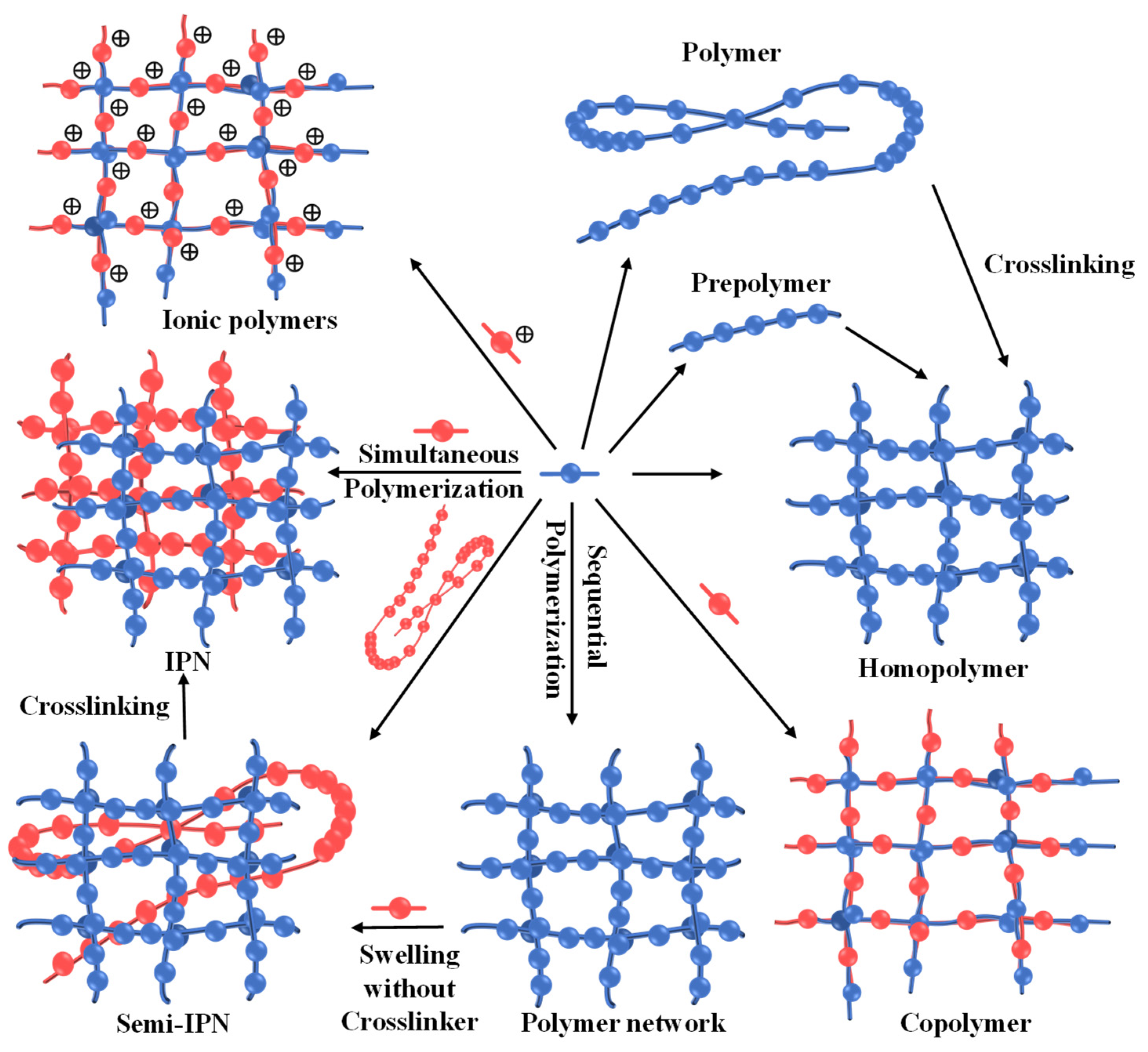
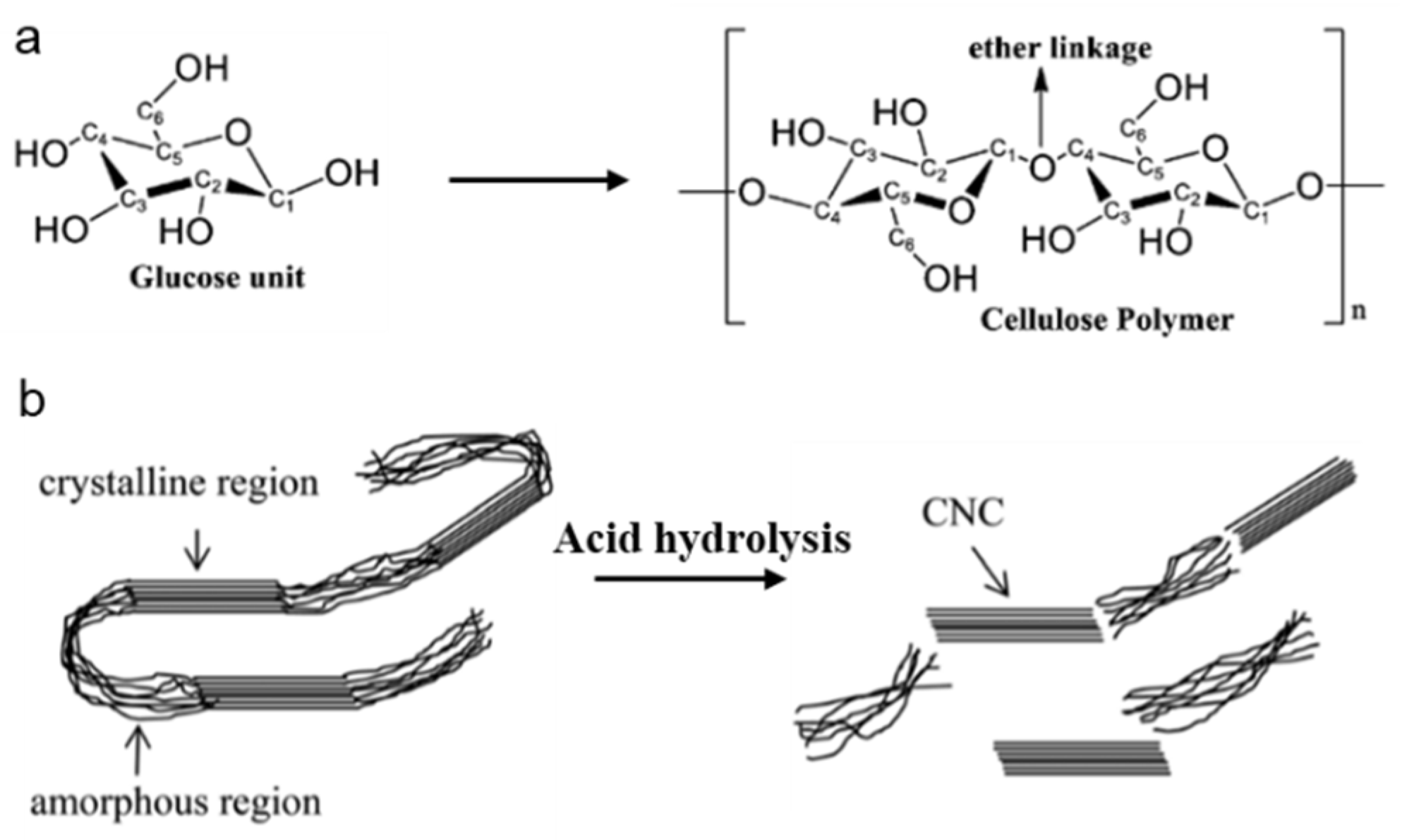
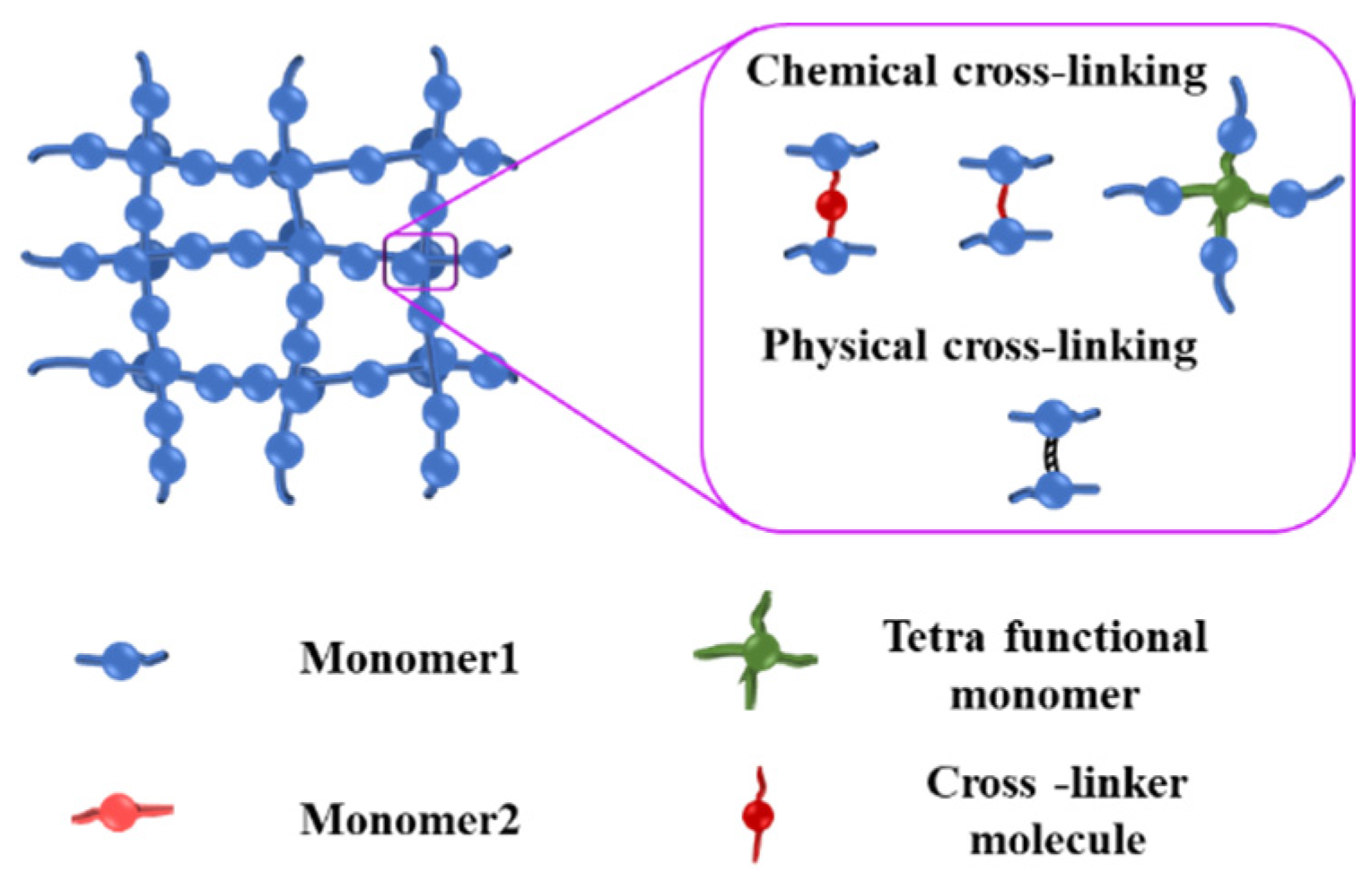
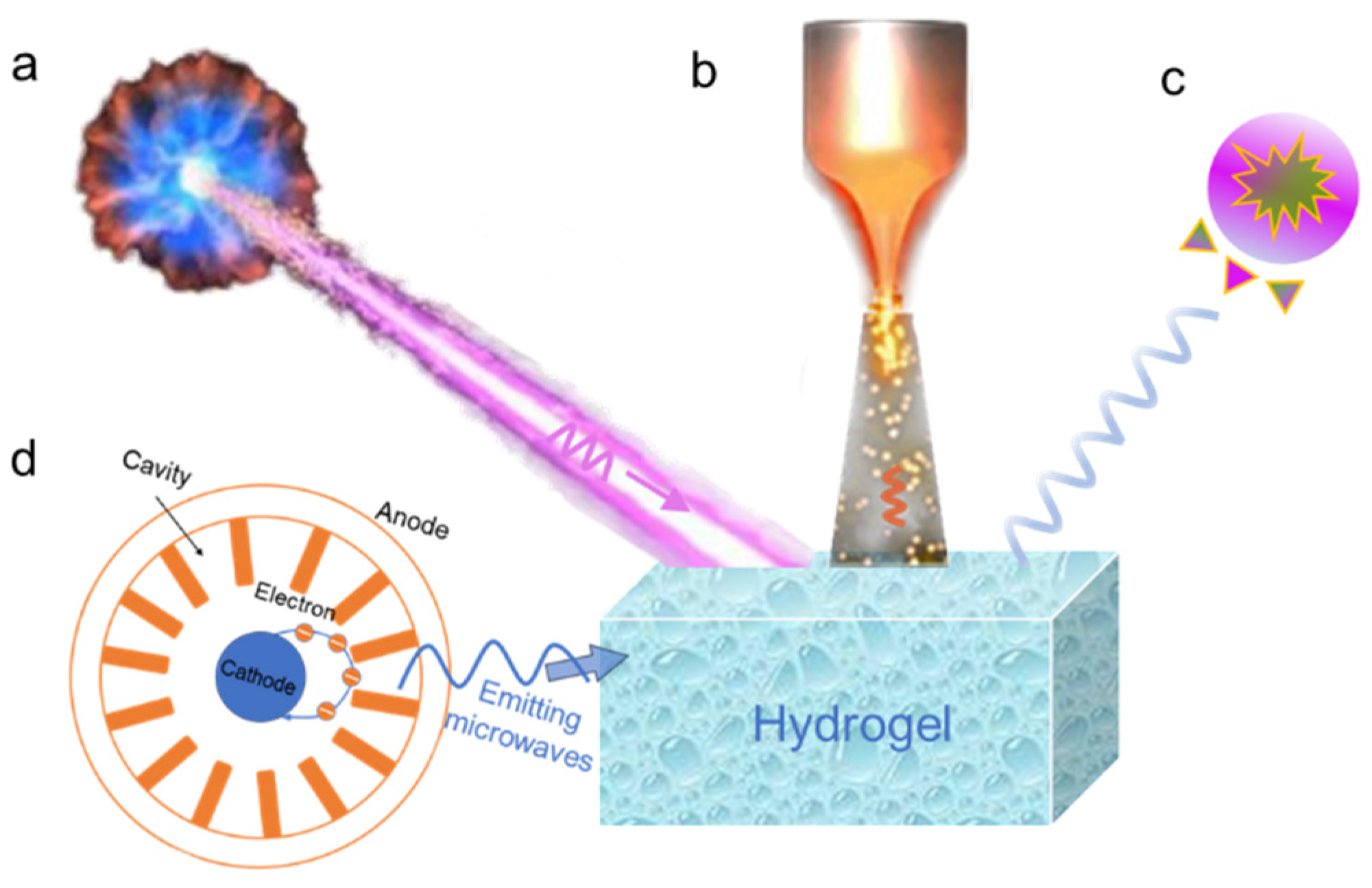


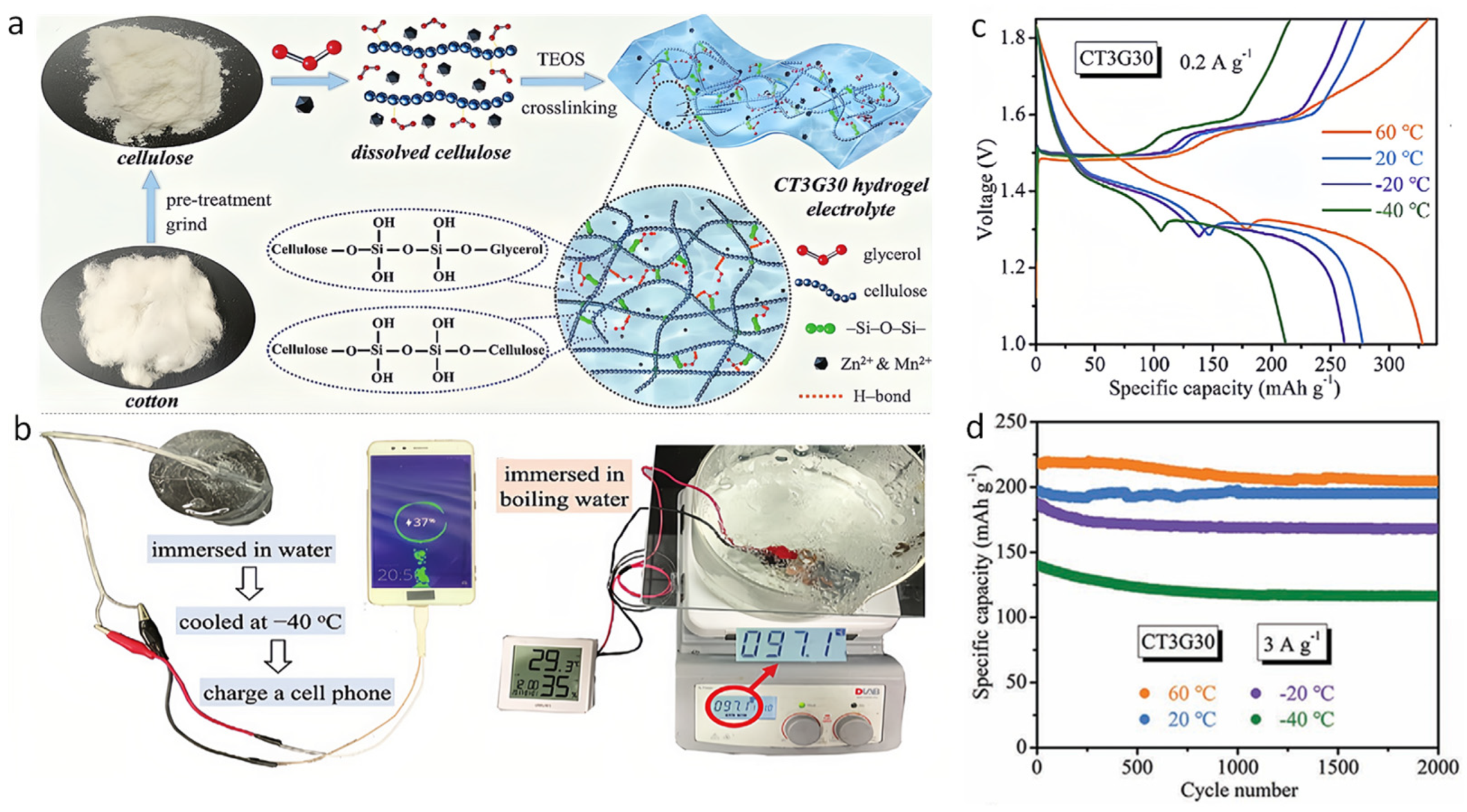
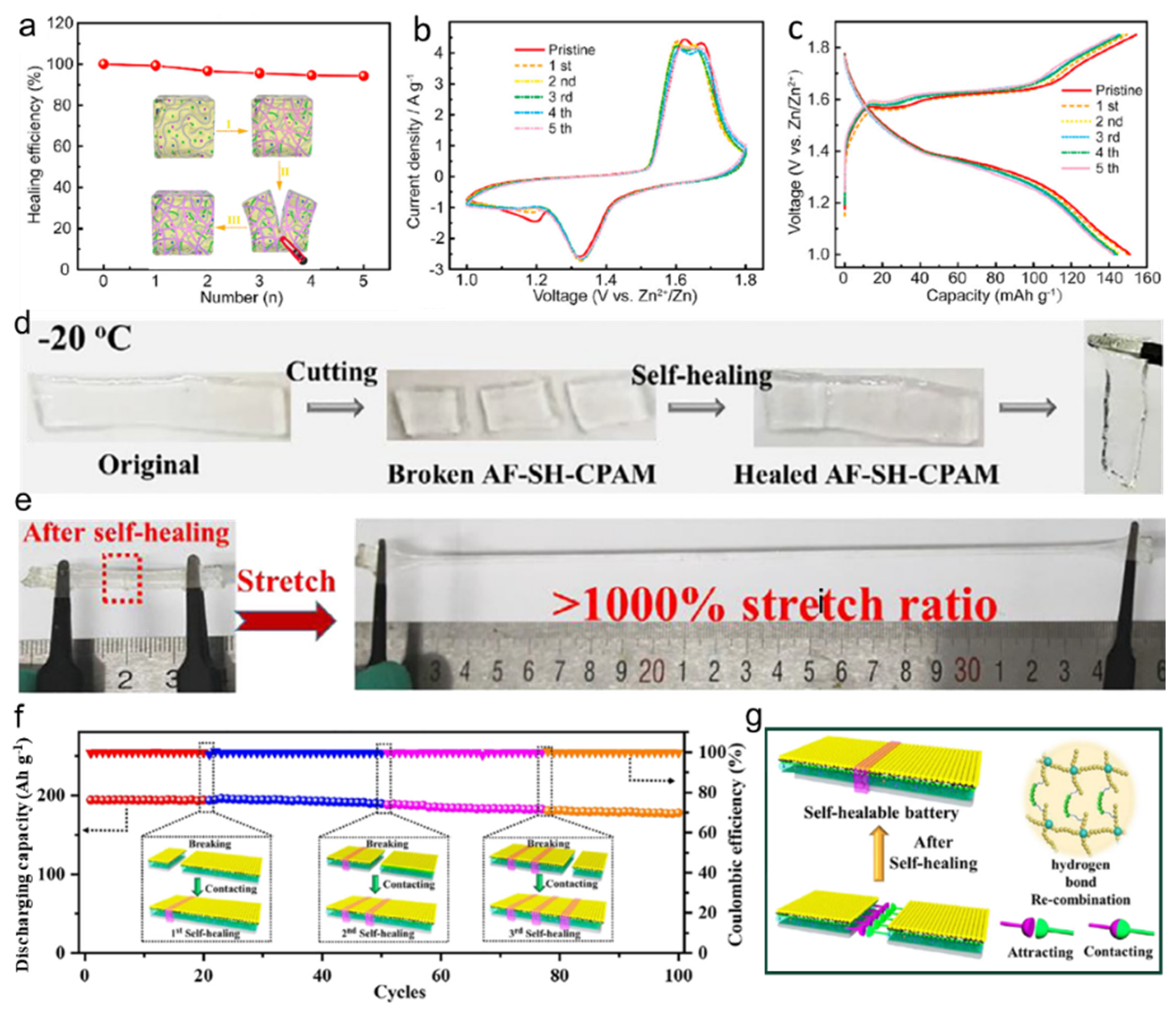
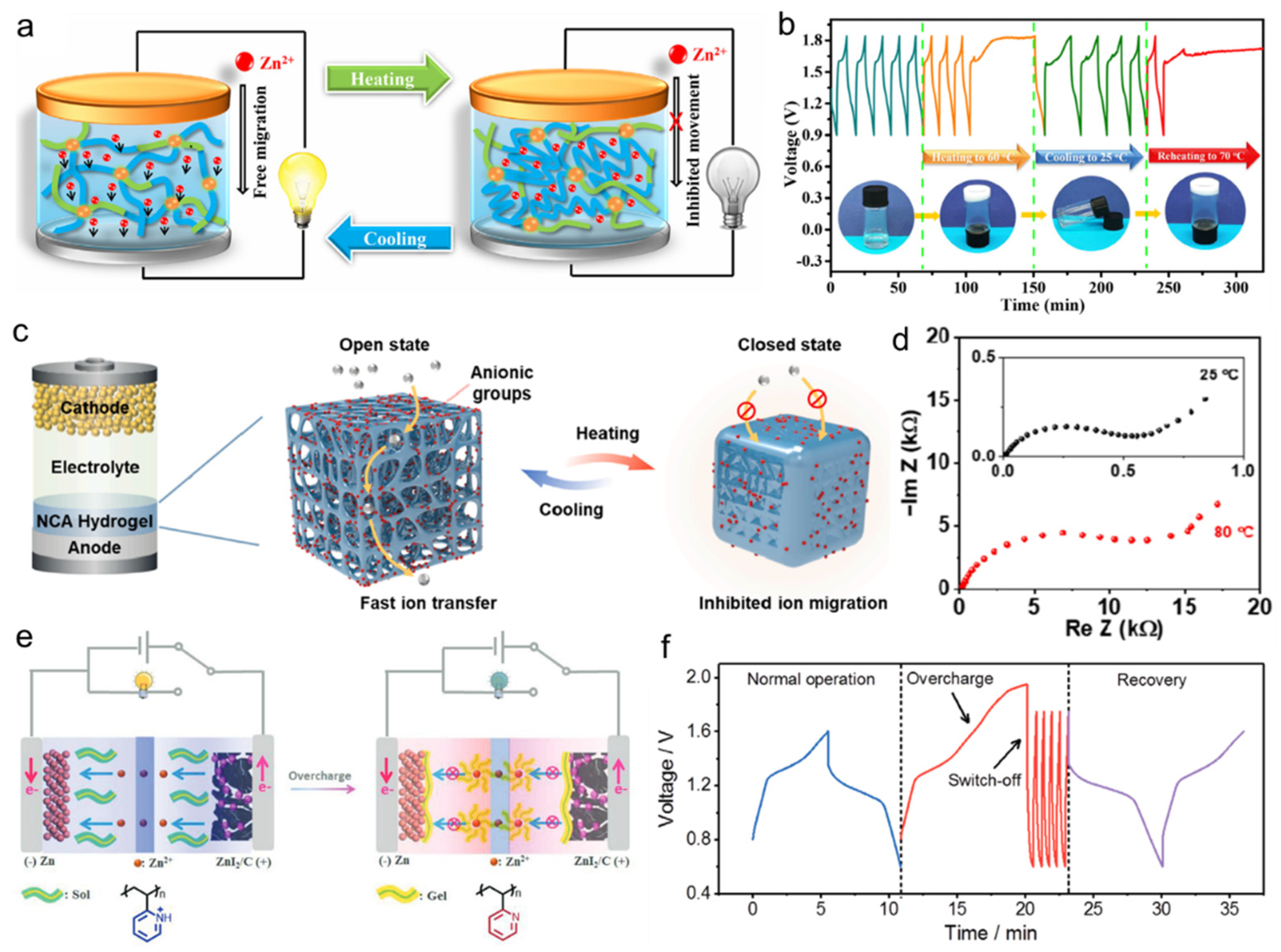
| Names of Hydrogel | Molecular Structures | Functional Groups | Features | Ionic Conductivity (S∙cm−1) | Cathode Material | Mechanical Properties |
|---|---|---|---|---|---|---|
| Poly(ethylene oxide) (PEO) |  | Hydroxyl | Reusable | 1.09 × 10−6– 6.33 × 10−3 | MnO2 140 mAhg−1 0.5 mAcm−2 | Physical crosslinking, flexible |
| Polyacrylamide (PAM) |  | Amide | Reusable | 2.15 × 10−3 | V2O5 271 mAhg−1 2C | Chemical crosslinking, stretchable |
| Polyacrylic acid (PAA) |  | Carboxyl | Self-healable | 0.288 | MnO2 5.6 mAhcm−2 0.5 mAcm−2 | Physical/ chemical crosslinking, stretchable |
| Sodium polyacrylate (PANa) |  | Sodium carboxylate | Self-healable, alkali resistant | 0.17 | NiCo 259 mAhg−1 5.8 C | Physical crosslinking, stretchable |
 | |
| Cellulose derivatives and R* | Reaction mechanism |
| MC [R*: H, CH3] | RONa + CH3Cl→ROCH3 + NaCl |
| HPC [R*: H, CH2CH(OH)CH3] | RONa + CH2CH(OH)CH3Cl→ROCH2CH(OH)CH3 + NaCl |
| HPMC [R*: H, CH2CH(OH)CH3] |  |
| CMCNa [R*: H, CH2COONa] | RONa + ClCH2COONa→ROCH2COONa + NaCl |
| HEC [R*: H, CH2CH2OH] |  |
| EC [R*: H, CH2CH3] | RONa + CH2CH3Cl→ROCH2CH3 + NaCl |
Disclaimer/Publisher’s Note: The statements, opinions and data contained in all publications are solely those of the individual author(s) and contributor(s) and not of MDPI and/or the editor(s). MDPI and/or the editor(s) disclaim responsibility for any injury to people or property resulting from any ideas, methods, instructions or products referred to in the content. |
© 2024 by the authors. Licensee MDPI, Basel, Switzerland. This article is an open access article distributed under the terms and conditions of the Creative Commons Attribution (CC BY) license (https://creativecommons.org/licenses/by/4.0/).
Share and Cite
Xu, L.; Li, Y.; Fu, J.; Shi, L.; Li, C.; Ma, R. Advances in Functional Cellulose Hydrogels as Electrolytes for Flexible Zinc-Ion Batteries. Nanomaterials 2024, 14, 1645. https://doi.org/10.3390/nano14201645
Xu L, Li Y, Fu J, Shi L, Li C, Ma R. Advances in Functional Cellulose Hydrogels as Electrolytes for Flexible Zinc-Ion Batteries. Nanomaterials. 2024; 14(20):1645. https://doi.org/10.3390/nano14201645
Chicago/Turabian StyleXu, Luo, Yan Li, Jianxue Fu, Luwei Shi, Chunjie Li, and Ruguang Ma. 2024. "Advances in Functional Cellulose Hydrogels as Electrolytes for Flexible Zinc-Ion Batteries" Nanomaterials 14, no. 20: 1645. https://doi.org/10.3390/nano14201645
APA StyleXu, L., Li, Y., Fu, J., Shi, L., Li, C., & Ma, R. (2024). Advances in Functional Cellulose Hydrogels as Electrolytes for Flexible Zinc-Ion Batteries. Nanomaterials, 14(20), 1645. https://doi.org/10.3390/nano14201645






